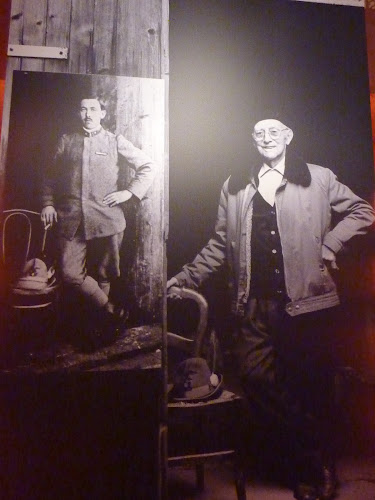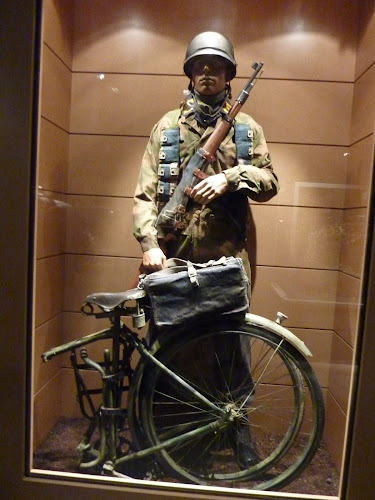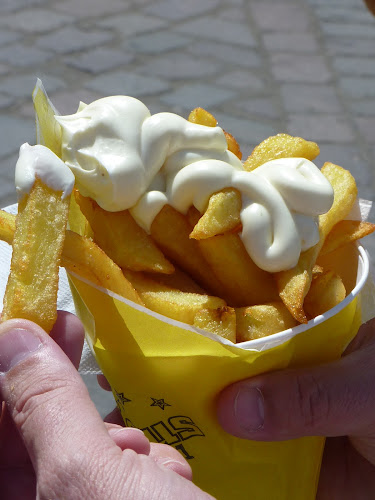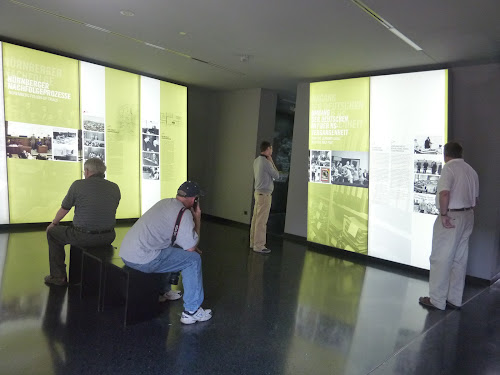On our way out of Prague this morning we stopped by the spot where the assassination of Reinhard Heydrich occurred. It's a fascinating story that's mostly unknown (unless you're a Czech).
Then we drove back into Germany to Nuremberg, to visit two major sites. First was the Nazi party rally grounds, the site where many of the iconic photos of masses of "Brown Shirts" were taken. The party would hold yearly week-long meet-ups here, with camping, athletic events and enormous rallies in which Hitler and other leaders would work up the crowd.
We went to the main rally ground with its marble stands. It's still used somewhat, but beginning to fall into disrepair. It was called the Zeppelin field because blimps used to land here.
We walked around the lake (this was a recreational area with boating and a zoo long before the Nazis transformed it) and had... you guessed it... bratwurst and beer for lunch. Saw several burly tattooed guys, one of which had the Nazi eagle with swastika in a circle design, but the circle was a solid blue dot. Of all of the places we've been this one feels the most like it could be a pilgrimage spot for Neo Nazis. It just feels sort of dirty. Did not get a picture of the tattoo. The folks at the food stand were very nice, by the way.

Around the lake is the enormous colosseum that was only half finished before the war started. The walls are 37 meters high, with another 30 meters and a roof planned, and to seat 50,000 people. Hitler's favorite architect Albert Speer designed all of these monumental structures - I wouldn't recommend him for a kitchen remodel. They've obviously had a difficult time over the years figuring out what to do with it. One proposal was a shopping mall. Today it houses a symphony in one of the side buildings and a museum, which was fairly interesting. The best bit was a film of the American GIs blowing up the swastika above Hitler's podium.
Note the white van in this photo. This place was enormous.
An enormous road was the backbone of the area and was to lead to a rally ground much larger than the Zeppelin field, where they could stage tank formations and large battle reenactments. It was never finished.
If you'd like to see some excellent imagery of what the rallies were like watch the propaganda movie "Triumph of the Will" on YouTube. This and other films by Leni Riefenstahl were very influential. We saw an interesting photo the other day in the Schindler factory museum of the filmmaker while she was in Poland. She had quite a distressed look on her face watching an officer shoot a captive.
Next we drove past the Nuremberg center. Looks like some nice things in there, though the city was heavily bombed so much is new and unremarkable. We headed to the court house where the trials were held. You can see the court room, which is still in use.
The museum is excellent, going into quite a bit of detail about the tribunal, including the evidence, judges, defense strategies, lawyers, media, verdicts, etc. A must see if you have any interest in law. Of course most of the major perpetrators were hung, but I hadn't realized that there were quite a number of additional trials. Many high ranking military and civilian officials got off very lightly. IG-Farben (they made the gas at Aushwitz), Bayer, BASF - lots of names you'd recognize.
From there we headed to Rothenburg, our next overnight stop.

























































